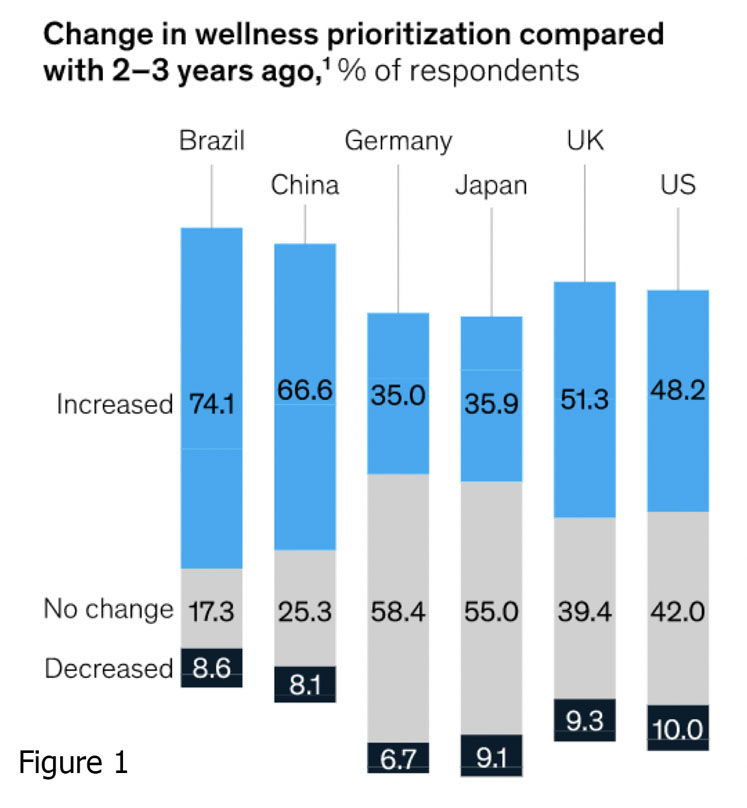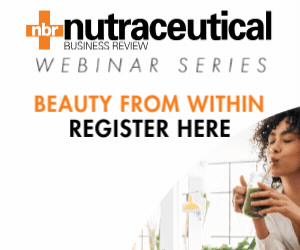Today’s consumers are much more conscious about, and actively interested in, ways to balance their body and mind. It’s a global trend playing out in multiple markets and presents nutraceutical brands with increased demand. Surely, this development opens the possibility of new product combinations.
Dr Kevin Robinson spoke with Jessica Philipp, R&D at SIRIO Europe, ahead of her live session at Vitafoods. She explained how softgel formulations which benefit well-being, can be created successfully.
KSR: Can you give an overview on why well-being softgels are generating renewed interest?
JP: Recently — accelerated by the COVID pandemic — consumers have been seeking out more products to support well-being/mental health. The rate of people interested in well-being increased by a striking 35–74% according to McKinsey (Figure 1).
But why do softgels raise so much interest? When you look at well-being, we are mostly talking about multiple body and mind benefits. Products that target this segment should offer more than one advantage. A very sophisticated way to achieve a multiple benefit formulation is to go for softgels that contain functional oils and botanical extracts.

Although, historically, interest in wellness and balanced mental health has always been on a high level in countries such as Germany, a longing to feel physically healthy and mentally balanced is seemingly universal throughout most markets now.
KSR: What ingredients and/or combinations will see the biggest growth opportunities?
JP: There are a couple of key trends that related to finished products, not just ingredients. We see omega-3 is growing here, especially from algae and hemp oil among others. Botanical ingredients are witnessing a sharp uptick in consumer interest. Ginseng is a good example, but lesser known ingredients such as hops or bilberry are also being used in botanical softgel formulations.
Likewise, with a better understanding of the gut-brain axis, probiotics continue to grow in popularity. It’s fascinating how a healthy microbiome could help to support other aspects of our health and mood. We’re learning so much more with each study.
KSR: With Vitafoods in mind, what advice would you give to nutraceutical brands looking to work with a CDMO to introduce a new mood/mind formulation?
JP: The first thing to find out is how much experience a CDMO has in developing such and formulations. For example, what do they do to ensure quality in every product and how transparent is their supply chain? Both consumers and nutraceutical brands are now asking for more clarity throughout the whole sourcing and development process. Good indicators are quality certifications, organic and other sustainability endorsements and proof that they take the protection of marine life seriously.
Concerning technical challenges, you want the CDMO to be able to tell you straight away which ingredients can be used in combination in a softgel and which cannot. That development experience is critical as complex formulations may experience interactions that adversely affect shelf-life, product stability and/or overall quality.

In addition, the CDMO should be able to guide the brand customer regarding what’s needed in terms of dosage and label claims. The sponsor company must be able to support the claims they make when it comes to marketing. The other major trend is that consumers want to know where their products are coming from and what is the quality/reliability of ingredients used. CDMOs need to take this into account.
KSR: What other quality aspects, such as regionality, are important?
JP: Beyond a transparent supply chain, both consumers and nutra brands understand that regionally sourced ingredients represents added value If, for example, we combine a plant-based oil from algae with hops (from Bavaria in our case), regionality offers another quality factor.
This means that a locally available ingredient in Germany can be used to create an entirely new well-being formulation. In our case, the formulation is suitable for those looking to reduce stress, anxiety and fatigue … and is even more appealing because it contains on-the-doorstep ingredients.
In fact, apart from ginseng, all the botanicals we’ll discuss in our session at the event are grown and originate from within Europe. For certain types of consumers, this is certainly going to be something they look for and are potentially also willing to pay more for.
KSR: What’s behind the rising interest in botanicals and what trends might we see in terms of their use with softgels?
JP: Mixing an omega-3 (whether from a traditional marine oil or from a plant-based linseed or hempseed oil) with botanical extracts is on the rise and a number of well-known botanicals are experiencing a kind of renaissance. Less well-recognised extracts are also becoming more popular with consumers; they’re increasingly being seen as a beneficial solution to support natural balance of well-being.
Combining omega-3 and ginseng is a popular option. Ginseng has been used for a very long time for its mental health benefits, such as improved vitality and energy. In fact, its Latin name Panax means “all healing,” which is a strong indicator of its varied applications; using it alongside omega-3 will give finished products additional EFSA-approved claims.
Another example would be combining ginseng with evening primrose oil — which helps to maintain healthy skin — for a more holistic wellness and vitality product.
When consumers look well and feel refreshed, they also often feel good. But, it’s not all about ginseng; saffron, hops, turmeric and many others have interesting benefits and are perfect partners for an essential oil in a softgel.
KSR: What kind of challenges do you see when combining botanicals in multiple-benefit softgels?
JP: It’s a major challenge to select suitable botanicals with supporting science-based data and substantial consumer need. All the regulatory hurdles must be overcome too. Advanced technical know-how is necessary to mix oils such as hemp with botanical extracts and other health ingredients, vitamins and minerals in a softgel.
For botanical extracts, the most important aspect — beyond the benefit of the ingredient — is to ascertain where it was sourced from and ensure that it is GMO-free, all-natural and well-studied. Saffron is a good example of this. Plus, a good CDMO will demand a standardised extract and retest the ingredients before use.
In each capsule, it’s critical to have enough high-quality extract to produce the beneficial dose. So, make sure you know your ingredients, your suppliers and the exact requirements of those ingredients to achieve the necessary effect. To combine botanicals with oils in softgels, you should talk to a premium CDMO who meets the highest quality standards and has a pedigree of experienced in this market.
Vitafoods session details: “Softgels on Top of Trends: Mental Wellbeing, Energy and Vitality,” Wednesday 11 May at 12:00.




